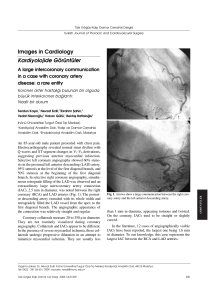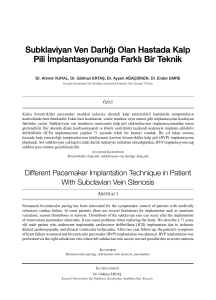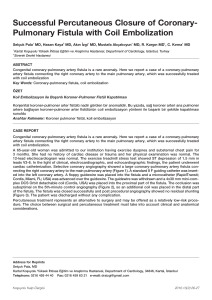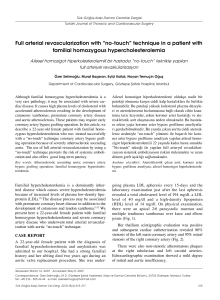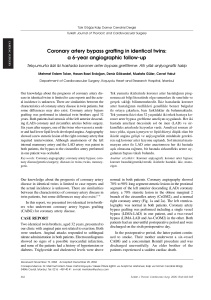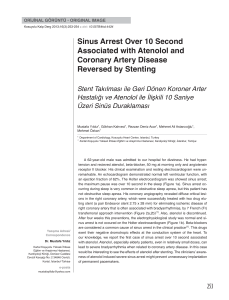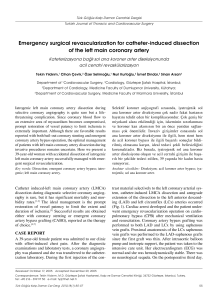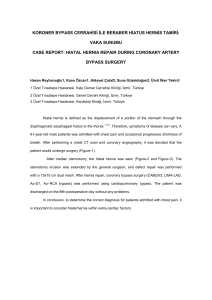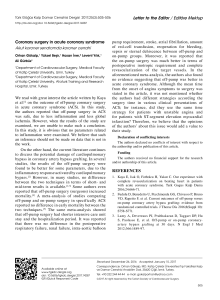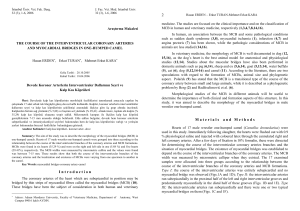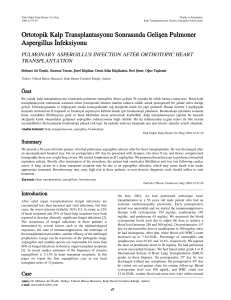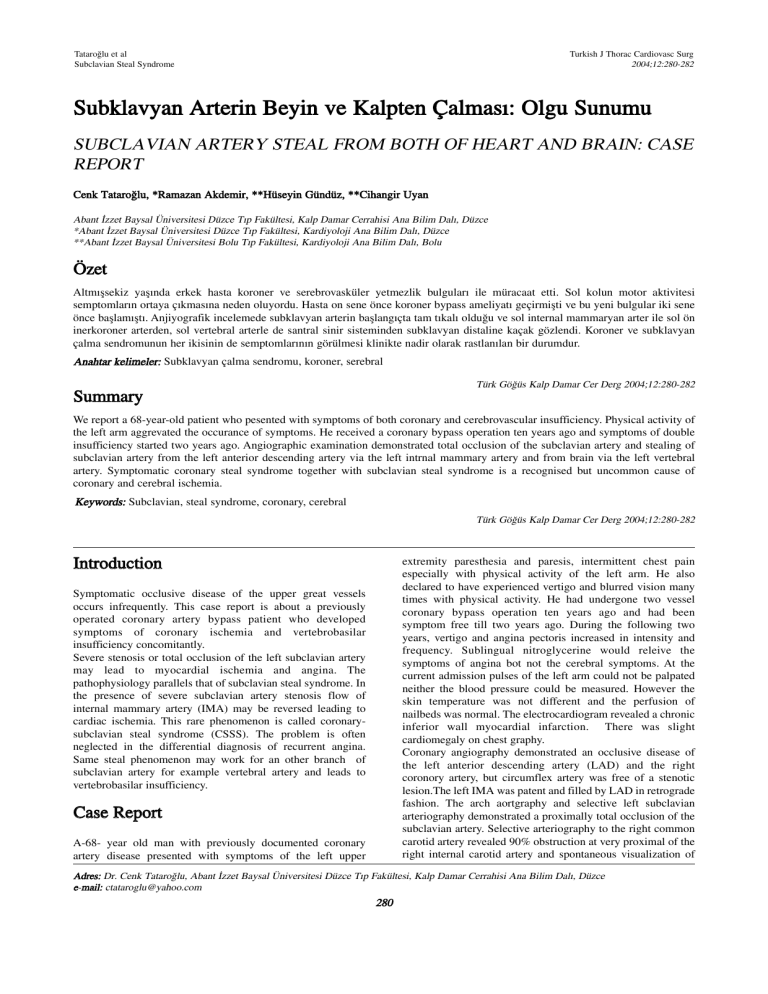
Tataroðlu et al
Subclavian Steal Syndrome
Turkish J Thorac Cardiovasc Surg
2004;12:280-282
Subklavyan Arterin Beyin ve Kalpten Çalmasý: Olgu Sunumu
SUBCLAVIAN ARTERY STEAL FROM BOTH OF HEART AND BRAIN: CASE
REPORT
Cenk Tataroðlu, *Ramazan Akdemir, **Hüseyin Gündüz, **Cihangir Uyan
Abant Ýzzet Baysal Üniversitesi Düzce Týp Fakültesi, Kalp Damar Cerrahisi Ana Bilim Dalý, Düzce
*Abant Ýzzet Baysal Üniversitesi Düzce Týp Fakültesi, Kardiyoloji Ana Bilim Dalý, Düzce
**Abant Ýzzet Baysal Üniversitesi Bolu Týp Fakültesi, Kardiyoloji Ana Bilim Dalý, Bolu
Özet
Altmýþsekiz yaþýnda erkek hasta koroner ve serebrovasküler yetmezlik bulgularý ile müracaat etti. Sol kolun motor aktivitesi
semptomlarýn ortaya çýkmasýna neden oluyordu. Hasta on sene önce koroner bypass ameliyatý geçirmiþti ve bu yeni bulgular iki sene
önce baþlamýþtý. Anjiyografik incelemede subklavyan arterin baþlangýçta tam týkalý olduðu ve sol internal mammaryan arter ile sol ön
inerkoroner arterden, sol vertebral arterle de santral sinir sisteminden subklavyan distaline kaçak gözlendi. Koroner ve subklavyan
çalma sendromunun her ikisinin de semptomlarýnýn görülmesi klinikte nadir olarak rastlanýlan bir durumdur.
Anahtar kelim
meler: Subklavyan çalma sendromu, koroner, serebral
Türk Göðüs Kalp Damar Cer Derg 2004;12:280-282
Summary
We report a 68-year-old patient who pesented with symptoms of both coronary and cerebrovascular insufficiency. Physical activity of
the left arm aggrevated the occurance of symptoms. He received a coronary bypass operation ten years ago and symptoms of double
insufficiency started two years ago. Angiographic examination demonstrated total occlusion of the subclavian artery and stealing of
subclavian artery from the left anterior descending artery via the left intrnal mammary artery and from brain via the left vertebral
artery. Symptomatic coronary steal syndrome together with subclavian steal syndrome is a recognised but uncommon cause of
coronary and cerebral ischemia.
Keyw
words: Subclavian, steal syndrome, coronary, cerebral
Türk Göðüs Kalp Damar Cer Derg 2004;12:280-282
Introduction
extremity paresthesia and paresis, intermittent chest pain
especially with physical activity of the left arm. He also
declared to have experienced vertigo and blurred vision many
times with physical activity. He had undergone two vessel
coronary bypass operation ten years ago and had been
symptom free till two years ago. During the following two
years, vertigo and angina pectoris increased in intensity and
frequency. Sublingual nitroglycerine would releive the
symptoms of angina bot not the cerebral symptoms. At the
current admission pulses of the left arm could not be palpated
neither the blood pressure could be measured. However the
skin temperature was not different and the perfusion of
nailbeds was normal. The electrocardiogram revealed a chronic
inferior wall myocardial infarction. There was slight
cardiomegaly on chest graphy.
Coronary angiography demonstrated an occlusive disease of
the left anterior descending artery (LAD) and the right
coronory artery, but circumflex artery was free of a stenotic
lesion.The left IMA was patent and filled by LAD in retrograde
fashion. The arch aortgraphy and selective left subclavian
arteriography demonstrated a proximally total occlusion of the
subclavian artery. Selective arteriography to the right common
carotid artery revealed 90% obstruction at very proximal of the
right internal carotid artery and spontaneous visualization of
Symptomatic occlusive disease of the upper great vessels
occurs infrequently. This case report is about a previously
operated coronary artery bypass patient who developed
symptoms of coronary ischemia and vertebrobasilar
insufficiency concomitantly.
Severe stenosis or total occlusion of the left subclavian artery
may lead to myocardial ischemia and angina. The
pathophysiology parallels that of subclavian steal syndrome. In
the presence of severe subclavian artery stenosis flow of
internal mammary artery (IMA) may be reversed leading to
cardiac ischemia. This rare phenomenon is called coronarysubclavian steal syndrome (CSSS). The problem is often
neglected in the differential diagnosis of recurrent angina.
Same steal phenomenon may work for an other branch of
subclavian artery for example vertebral artery and leads to
vertebrobasilar insufficiency.
Case Report
A-68- year old man with previously documented coronary
artery disease presented with symptoms of the left upper
Adrres: Dr. Cenk Tataroðlu, Abant Ýzzet Baysal Üniversitesi Düzce Týp Fakültesi, Kalp Damar Cerrahisi Ana Bilim Dalý, Düzce
e-m
mail: [email protected]
280
Türk Göðüs Kalp Damar Cer Derg
2004;12:280-282
Tataroðlu ve Arkadaþlarý
Subklavyan Çalma Sendromu
Figure 1. (a) Coronary angiography demonstrated retrograde
filling of the left IMA from LAD.
Figure 1. (c) Early visualization of the left vertebral artery after
radiopague injection to the right innominate artery.
were changed. More elderly and high risk patients, including
those with generalized atheroschlerosis, have been undergoing
operation. This group includes patients with concomitant
occlusive disease of the coronary arteries and great vessels.
Severe stenosis or total occlusion of the left subclavian artery
may lead to myocardial ischemia and angina due to reduced or
reversed blood flow through a previously placed IMA bypass
graft to the coronary artery. The frequency of CSSS is reported
to be between 0.4 and 1.1 percent in coronory artery bypass
patients [1,2]. Most often the diagnosis of CSSS is brought to
attention by recognition of reversed blood flow in IMA during
rutine post operative angiography. Most authors regard this as
a diagnostic finding.
Total cerebral blood flow significantly decreases in patients
with subclavian steal syndrome in which the neurologic
symptoms come out. Subclavian steal phenomenon can be
more likely to cause significant neurologic symptoms in
patients with disease in other arteries supplying the brain. This
patient’s neurologic findings can be attributed to internal
carotid stenosis and contralateral subclavian obstruction
presenting together and enhancing their effects to steal blood of
the brain.
Subclavian stenosis or occlusion can be diagnosed by
ultrasonography or more recently by magnetic resonans
imaging [3]. It is utmost important to diagnose subclavian
stenosis before bypass surgery. Bilateral upper extremity blood
pressure measurements are an excellent screening tool for
detecting the presence of subclavian artery stenosis. A blood
pressure difference of more than 20 mmHg is highly suggestive
of subclavian artery stenosis [4]. However the absence of
difference in extremity blood pressure does not exclude the
presence of subclavian artery stenosis because the frequent
occurance of innominate, bilateral subclavian, and diffuse
atherosclerotic occlusive disease in these patients [5]. When
Figure 1. (b) Selective left subclavian arteriography revealed
total obstruction.
the left vertebral artery short after radiopague was injected into
the innominate artery (Figure 1).
Discussion
During the last decade, the demographic characteristics of
patients who presented for elective coronary revascularization
281
Tataroðlu et al
Subclavian Steal Syndrome
Turkish J Thorac Cardiovasc Surg
2004;12:280-282
screening for subclavian artery stenosis it is advocated
ultrasonographic duplex scanning with hemodynamic
measurements before and after exercise to be more reliable
than the assessment for discrepancy in upper extremity blood
pressure. This method is also effective for documenting
patency after an interventional procedure [6].
After the presence of CSSS is ascertained there are various
treatment modaities. Treatment of CSSS is directed towards
treating the subclavian artery stenosis. Successful correction
with relief of symptoms has been accomplished by carotid
subclavian bypass [7], angioplasty [8], or atherectomy [9] of
the subclavian artery. Before deciding the type of interventional
procedure it is exceedingly important to visualize the arch
vessels in order not to omit an other stenotic lesion in this
multicircular system. This will help us to fully comprehend the
pathophysiology and determine the right strategy.
4.
5.
6.
7.
8.
References
1. Gutierrez GR, Mahrer P, Aharonian N, Mansukhani P,
Bruss J. Prevalence of subclavian artery stenosis in patients
with
peripheral
vascular
disease.
Angiology
2001;52:18994.
2. Olsen CO, Dunton RF, Maggs PR, Lahey SJ. Review of
coronary-subclavian steal following internal mammary
artery-coronary artery bypass surgery. Ann Thorac Surg
1998;46:667-78.
3. Tuseth V, Hegland ³, Fjetland L,Nilsen DWT. Reversed
flow in internal mammary artery conduit and vertebral
9.
282
artery with left subclavian artery occlusion causing angina
and vertigo the coronary-subclavian steal syndrome. Int J
Card 2001;79:311-4.
Marshall WG Jr, Miller EC, Kouchoukos NT. The
coronary-subclavian steal syndroome: report of a case and
recommendations for prevention and management. Ann
Thorac Surg 1998;46:93-6.
Takach TJ, Reul GJ, Cooley DA. Concomitant occlusive
disease of the coronary arteries and great vessels. Ann
Thorac Surg 1998;65:79-84.
Takach TJ, Reul GJ, Gregoric I. Concomitant subclavian
and coronary artery disease. Ann Thorac Surg
2001;71:187-9.
Fitzgibbon GM, Keon WJ. Coronary-subclavian steal : a
recurrent case with notes on detecting the threat potential.
Ann Thorac Surg 1995;60:1810-2.
Shapira S, Braun SD, Puram B. Percutaneous transluminal
angioplasty of proximal subclavian artery stenosis after left
internal mammary to left anterior descending artery bypass
surgery. J Am Coll Cardiol 1991;18:1120-3.
Breall JA, Grossmann W, Stillmann IE. Atherectomy of the
subclavian artery for patients with symptomatic coronary
subclavian steal syndrome. J Am Coll Cardiol
1993;21:1564-7.

